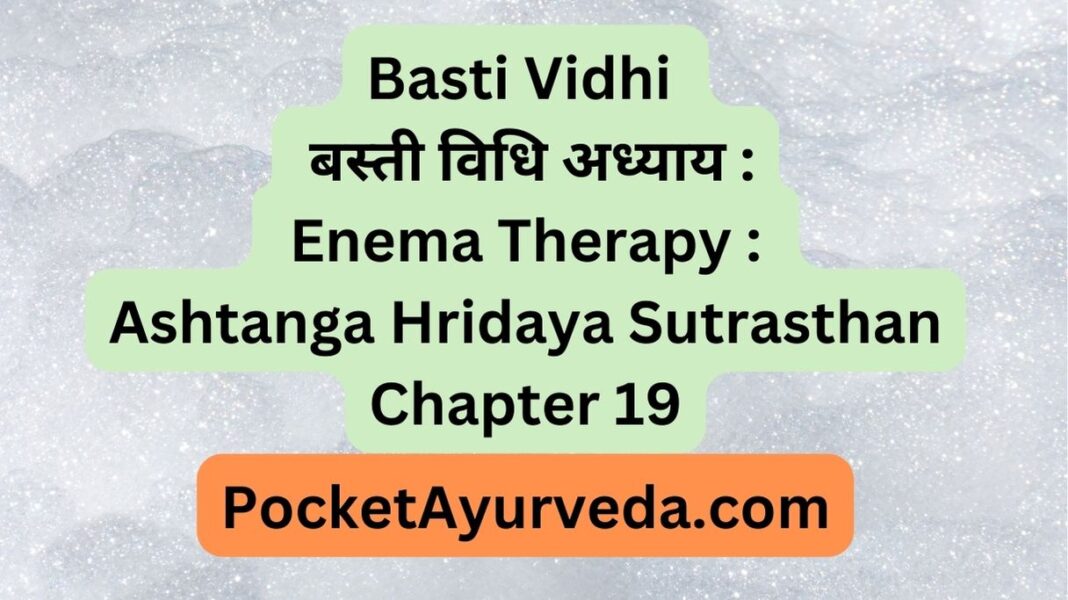Basti Adhyaya of Ashtanga Hridaya describes the procedure that is involved in Basti treatment – Enema. Basti generally refers to the practice of enema therapy.
Basti indications


Basti is a treatment used in conditions that are caused by,
Doshas that are imbalanced and have a predominant role in Vata or for illnesses resulting from Vata imbalance by itself,
It is the best of all treatment options.
Basti Types
It can be classified into three types of which are
Niruha Basti – Decoction enema – Asthapana Basti
Niruha often referred to by the name of Asthapana Basti Decoction, a decoction of enema that is mixed with honey, salt, and ghee is used to treat.
Anuvasana Basti – Fat Enema – Sneha Basti
Anuvasana also also known as sneha basti in which oil, ghee and fat are used to administer. Herbal oils like Narayana Taila, Herbal ghrita’s are commonly used for this purpose.
UttarBasti – Both Decoctions and fats can be used.
Uttarabasti is administered via the urethral route.
Notes: Basti refers to the urinary bladder. In earlier times, the bladders of animals such as buffalo, etc. were used as bags to store the enema materials like oils, decoctions, etc.
People suitable for Niruha Basti – Niruha Yogya – Asthapaya – Asthapana Arha
Persons suitable for Niruha Basti -Asthapya Asthapana Arha
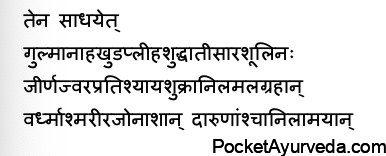

Patients who suffer from
Gulma – Tumors of your abdomen
Anaha – bloating, fullness
Khuda – gout,
Pleeha – Spleen disease, Splenomegaly Shuddha atisara Diarrhoea that is not a result of other diseases Shula abdomen pain
Jeernajwara – Chronic fever
Pratishyaya rhinitis Shukra, Anila, Mala Graha – semen blockage flatus, constipation, Vardhma – an increase in the scrotum
Ashmari – Urinary Calculi
Rajonasha – Amenorrhoea and Vata-related grevious illnesses. 2-3
Niruha Ayogya – Unsuitable for Niruha Basti – Asthapana Anarha – Anasthapyah


Unsuitable for Niruha Basti – Asthapana Anarha – Anasthapyah
Atisnigdha who has had an excessive oleation therapy
Urakshata – Chest injury
Krusha is extremely thin,
Ama Diarrhoea / Atisara dysentery as a result of Ama or diarrhea with recent first onset, vomiting, Samshuddha who has just undergone purification treatments (Panchakarma), Datta Navana – who have received nasal medications
Shvasa – COPD, Asthma, Dyspnoea
Kasa – cold, cough Praseka excessive salivation
Arsha – Hemorrhoids
Hikka – Hiccups
Adhmana Abdominal bloating Alpavahni– – low digest strength Shunapayu Swelling of the lower rectum Ahara People who just took food and had an intestinal obstruction Chidra Udara A rupture in the intestines Udakodara – Ascites Kushta – skin diseases
Madhumeha – diabetes
A woman is pregnant in the seventh month. 4-5
Patients suitable for Anuvasana Basti – Anuvasana Arha – Anuvasya – Anuvasana Yogya


Patients suitable for Anuvasana Basti Anuvasana Arha – Anuvasya
People who are who is suitable for Asthapana are ideal for an oil-based enema (Anuvasana).
Particularly those with powerful digestion powers and who have dry skin, but have or have not received Snehana therapy, and suffer from vata-related diseases. 6
Anuvasana Ayogya – Patients not suitable for Anuvasana – Nanuvasyh – Anuvasana Anarha
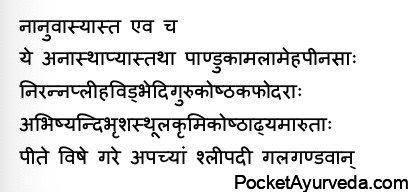

Patients not suitable for Anuvasana
People who are not suitable for oil include all of the following
not suitable for decoction enemas people suffering from
Pandu Anemia
Kamala – Jaundice,
Meha – the urinary tract, diabetes, and other disorders
Peenasa – rhinitis
Niranna is on a diet that is empty. (On empty stomach)
Pleeha Spleen Disease Splenomegaly, Pleeha Disease of the spleen
Vid bhedi – diarrhea,
Guru koshta is a hard stool-constipated
Kaphodara Kapha kind of Ascites
Abhishyandi – an eye disorder
Bhrusha Sthula – profound obesity,
Krumi Koshta – intestinal worms
Adhyamaruta – gout;
Consuming poison, or suffering from goiter, artificial poison, or filariasis. 7-8
Bastinetra – enema nozzle


Bastinetra enema nozzle
Enema nozzles should be constructed with metals like silver, gold , bamboo, bone.
Gopuchhakara is shaped like the tail of a cow’s tail,
Achidra – without hole (except on the edges) and straight, smooth, and with Gulikamukha and a tip that resembles the shape of a pill. 9
Size of Bastinetra – Basti Nozzle Size
For children younger than 1 year of age, the nozzle should be 5 angula in length of the fingers of the child.
1 – 7 years old The age is 6 Angula
7 years, it’s 7 Angula. 12 years and 8 Angula
16 years and 9 Angula
20 years from now is best to limit it to 12 angulas.
The measurements might be slightly higher in different age groups, based on strength, age, and structure. 10-11
Basti netra diameter
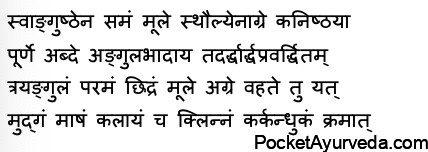

The diameter of the orifice at its base should be 1 Angula in size for infants of 1 year old.
The diameter of the orifice must be increased by 1/2 Angula for various age groups, and its maximum capacity is 3 Angula in diameter.
The orifice must allow for the free flow of the soaked Mudga (green Gram), Masha (black gram), Kalaya (round pea), and seeds of Karkandhu Jujube. 12-13
Basti Nozzle Karnika


At the source at its root, a Karnikaor ear-like ridge of similar size to the orifice needs to be created during the process of creating the nozzle.
A second Karnika ridge must be constructed with a distance of two Angula towards the end, and the orifice near the point should be shut with a piece made of cloth.14-15.
Basti Putaka Enema bag
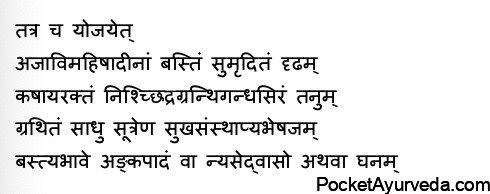

Basti Putaka- Enema bag
The bladders of goats buffalo, sheep, or any other animal was used as an enema bag. The bladder should be robust and well-beaten. It was then made red through tanning using Astringent substances.
The bladder should be free of any holes, spots, or hard areas.
It shouldn’t be damaged.
To a bladder of this kind, large nozzle is adjusted and secured to the threads.
If the bladder isn’t available, the skin of the legs and thighs of animals or thick material can be used to make the bag. 15-17
Nowadays readymade plastic and rubber bags are available which are used as basti putaka..
Niruha Matra – quantity of medicine used for decoction enema
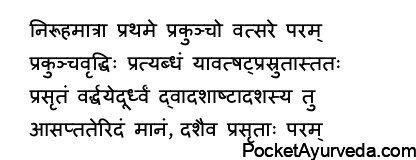

Niruha Matra (quantity of medicine for decoction enema)
For children up to 1 year of age The decoction enema amount is 1 prakuncha x one Pala equals 48gm.
Each year, it will be increased by 1 pala until it reaches six Prasruta/ 12 pala = 576gm;
If you are a 12-year-old, the number would be 12 Pala.
In the future, it must be the amount of 1 Prasruta (2 Palas= 96 grams). Every year until it reaches 12 Prasta- 24 Palas=1152gm.
At 18 years old it is 24 Pala.
18-70 years old – 24 Pala = 1152gm
After 70 years it will be decresing 1 pala each year. 10 Prasruta equals 20 Pala = 960 grams Ml 18-19.
Based on my clinical expirence nowadays 320ml is sufficient dose for Adult.
Anuvasana Matra- Quantity for oil enema


Anuvasana Matra- quantity for oil enema
The amount of oil for enema must be one-fourth of the amount of decoction enema according to the guidelines for each age category. 20
Anuvasana Basti vidhi – Method of fat Enema
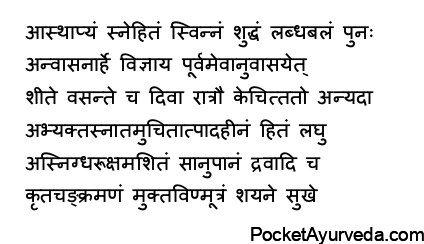



Anuvasana Basti Vidhi procedure of fat Enema
The patient who is suitable for enema is advised to administer the drug Snehana (oleation) as well as sweating therapies, followed by purification therapy, emesis or purgation (Vamana and or Virechana).
When he is able to regain his strength after following sansarjana karma, and if he determines that he’s fit to undergo an oil enema He should receive an oil enema prior to. This is the procedure to follow.
In the winter months (Hemanta as well as Shishira Ritus) in addition to Vasanta (spring) the ritual is recommended to be administered during the daytime in other seasons at night.
The patient should receive an oil-based massage as well as a bath. After that, he should be given the usual food should be reduced by one-fourth of the normal quantity; satiable light, and easily digestible without a lot of fats, or extremely dry. This should be followed by an appropriate after-drink.
Then, he’ll need to stroll for a while then wash out urine and faeces and then lie down on a comfortable cot, not too high or low on the left (Left Lateral Position) and fold his right thigh, and stretching his left thigh. 20-23
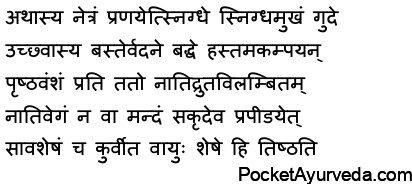

Then, the enema nozzle is lubricated. After the air in the bag is expulsed out after confirming that it’s properly attached to the nozzle. It is to be pressed with no shaking hands, and in toward the column of vertebrae. not too quick nor too slow, not using large force nor at the pressure being low, but with one go, a small amount of liquid material is left to stay inside the bag. 24-26
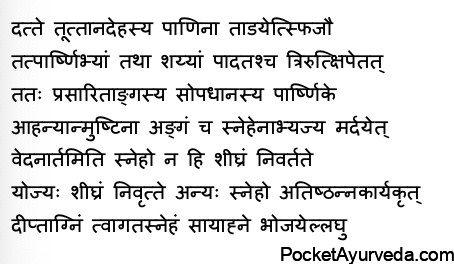

After administering and taking off the nozzle, the patient must be placed with his back up, his buttocks beat gently with the fingers of the physician, followed by the heels of the patient and the feet of the cot must be raised three times;
Then he needs to lie down, stretching his entire body with an inflatable cushion under his feet, and oil spread across the body and the various parts of it should be beaten with a fist or massaged. Concentrate on the areas that hurt the body, to ensure that the liquid from the fat enema in the rectum doesn’t appear until later.
If it is soon to come out an additional oil enema must be administered as soon as possible since the fat that is not left in the body does not fulfill its objective. If the patient has good digestion, and the fat does not come out within the prescribed time, he should be served light meals at night. 27- 29 1/2.
Time for anuvasana basti to come out
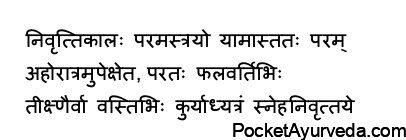

The time limit for fat to be absorbed out of the body is three Yama nine hours and after that, the fat can be kept for a full day and the night. Then after 24 hours following the administration, efforts to get rid of the fat by force, with the aid of rectal suppositories that are made of fruit or a strong decoction elimination. 30-31
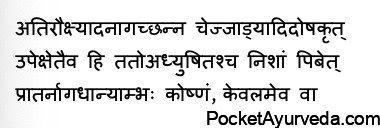

If it is not able to emerge due to severe dryness in the interior and does not cause any issues like lassitude or other. It should be ignored and kept inside all night long;
In the morning, he’s made to drink hot water, either made with coriander and ginger or plain. 32


Also, he should receive a fat enemas at the end of day three or five or until the fat is properly digested.
To whom can fat enema be daily administered?


To whom fat enema can be given daily
People who have a significant increase of vata and who engage in physical exercises daily as well as those with good digestion capacity and are extremely dry may receive a fat enema each day. 33-34


After 3-4 fat enemas, if your body is well-lubricated, a purification enema (Niruha Basti) is recommended to cleanse the channels. If the body is not properly lubricated, the fat enemas should be administered for the next. 35
Niruha Basti Vidhi : The procedure of decoction enema
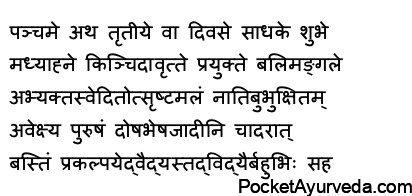

Niruha Basti Vidhi- Procedure of decoction enema
On the fifth or the third day after the fat enema and at an Auspicious timing, after midday, following the performance of Auspicious rituals, such as eating and oleation, following the elimination of wastes – urine and faeces if you have not eaten any heavy meals following an easy meal. After carefully analyzing the characteristics of the patient and their Dosha or Drugs and assisted by a variety of experts in the enema procedure, must give decoction enemas to the person. 36- 37 1/2
Niruha basti preparation of enema decoction
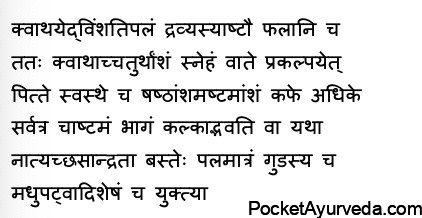

Niruha basti preparation of enema decoction
20 Pala (960 grams) of Drugs included in the prescription as well as
8. Madana Phala fruits should be prepared into a decoction using sixteen parts of the water (15.360 liters) and then boiled down to 1/4th volume. This means that 3.840 Liters of decoction can be produced.
To the decoction is added fat-based oil or ghee, etc.
1/4th amount = 960 grams to treat Vata,
1/6th amount = 640 g to treat Pitta,
1/8th amount = 480 grams to a healthy individual and to treat Kapha conditions. 1/8th quantity = 480 g for healthy people.
The amount of Kalka (Paste) of certain Drugs that are to be added into the mix to treat all Doshas and healthy people will be one-eighth (480 g) of decoction (480 grams) not too thin nor excessively thick following mixing.
The next one is Pala (48 grams) of Guda Molasses/Jaggery and a suitable amount of salt and honey are included.
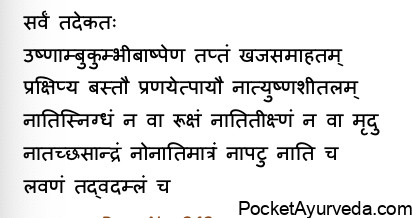

Then, all of them are combined, well churned by a churner, and kept warm by storing the container with hot water, or steam coming from a pot.
It is then to be put into the enema bags in the same condition, that is not too hot or too cold, not too dry nor too oily and not too strong or soft, nor too thick or thin either too thick or too little and not with too much of salt, is then placed to the inside of the rectum. 41-43
Quanity of dravyas in niruha basti
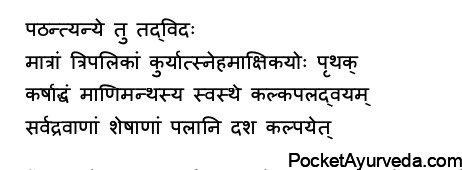

Other experts in enema treatment say that the amount of fats, oil, honey, and ghee must comprise three pala (144 grams) in each case;
Amount of Manimantha (Saindhava salt) for healthy will be half an Karsha 6 grams. the Kalka paste of drugs should be two Pala 96 g, and the total weight of the other liquids, the total will be 10 Pala, 480 g. 44-44 1/2
Order of preparation niruha basti – honey salt fat paste decoction


Salt, honey, paste (Kalka), fat (Oil), and decoction must be mixed successively in a sequential order, one after another It is the procedure for mixing the ingredients to make the decoction enema. 45 1/2
Position after basti karma


After having the enema, the patient should lie on his face up with an under-head pillow and be mentally focused on the enema. Once he has felt the urge, he should get rid of the faeces that are sitting on the heels of his feet.
The maximum time for decoction enema material to come out
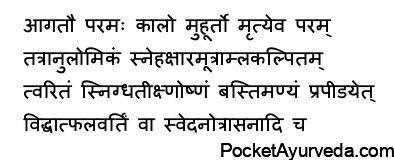

The time limit for decoction enema materials to be released can be as little as one Muhurta 48mins, after that period it could be fatal.
Therefore, a purgative enema that is prepared using fats, alkalies, and the urine of animals such as the cow, and sour substances and possessing nonctuous, penetrating and hot properties must be administered as soon as possible or by a rectal suppository made with fruits is recommended.
The use of shivering and frightned can also be used in order to cause the process of defecation. 47-48 1/2


If the substance is released at its own will and is not a problem, then the third or fourth enemas could be administered as many as needed until the patient shows signs of the proper enema therapy. 49


The signs of decoction enema therapy are comparable to the symptoms from purgation treatment. 49 1/2
Niruha Basti Paschatkarma
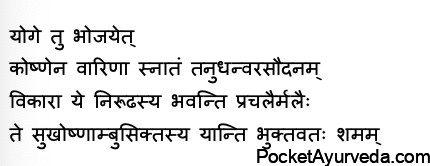

Following the onset of evident manifestations, the sufferer must get a bath in warm water and consume the rice and juice from animals living in desert-like land. The problems of decoction enema triggered by the Malas Doshas circulating will be relieved by a warm water bath and food.


If the patient is troubled with an increase in Vata the patient should receive an enema with fat immediately on the same day. 50-52


The signs of a proper excessive, insufficient and inadequate decoction enema treatment are the identical to the symptoms that are associated with the Snehana(drinking from fat) treatment.
Signs of the proper Anuvasana basti Procedure
Signs of proper Anuvasana basti Procedure


Enema material – fat flowing out, along with faeces, after some time and followed by flatus movement down are signs of a proper fat enema treatment .53
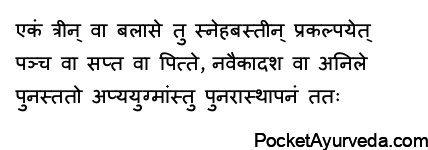

1 – 3 fat-based enema (Anuvasana) is recommended for treatment of Kapha dominant illnesses.
5 – 7 for Pitta,
9 – 11 for Vata.
On alternate days like third, fifth, Seventh, and so on. Decoction enemas should be administered. 54- 55
Be aware that Niruha Basti (decoction enema) is administered in empty stomach.
Anuvasana basti fat enema is administered shortly after food intake after the patient’s palms remain wet from hand washing, following the intake of food. (Ardra Pani Avastha)


Food should be provided in conjunction with
Anna Yusha (Soup made from rice grains) in the case of Kapha disorder, Milk is used in cases of Pitta disorder, and Meat juice or Meat soup in the case of the presence of Vata disorder. 55 1/2
Basti for vata dosha vitiation


In the event of an increase of Vata One enema comprised of decoctions of drugs that reduce Vata, Trivrt, and Saindhava mixed with fats, and liquids with a sweet and sour flavor that are warm and administered would be optimal. 56
Basti for pitta dosha vitiation


In the event of an increase in Pitta one enema made up of a decoction of the drugs Nyagrodhadi Gana and Padmakadi Gana, which is cold and sweet, and then blended with milk, ghee syrup, sugarcane juice, and honey is ideal.
Basti for aggravated kapha dosha


In the event of an increase in Kapha three enemas made up from decoctions of the drugs Argwadhadi Gana, and Vastakadi gana, which are mixed with honey or cow’s urine, which have intense, hot, and pungent properties are the best. 58


In the event of an increase of all Doshas this three-part enemas will reduce the Doshas that require another enema must be administered with all the qualities mentioned above.


Other physicians don’t want any other enema besides the three mentioned above because there is no fourth dosha that requires another enema should be administered.


Others say that only three types of enemas are made,
Utkleshana is the cause of the Doshas
Shodhana: which causes purification by removing Doshas. Shamana : which causes mitigation, which reduces them within the body. 61


All of these must be justified by the how strong the Doshas are or drugs, etc.


Enemas are administered and should be continued until signs of a proper enema appear.
Karma Basti – treatment using 30 Enemas


Karma Basti
An enemas course consisting of 30 including one fat enema at start and 5 at the conclusion with a decoction enema that is twelve and 12 fat enemas alternately in the middle. This is known as the Karma basti. Certain doctors with experience may offer two enemas a day. One enema a day is the standard.
F = Fat enema = Anuvasana = Snehabasti
D = Decoction enema = Niruha = Asthapanakarma basti numbers


Kala Basti 15 enema regimen


Kala Basti – 15 enema regimen
15 enemas including one fat enema in the start and 3 at the conclusion and six decoction in enemas and five fat enemas alternately in the middle is called Kala Basti.


Yoga basti 8-day enema regimen


Yoga Basti
Eight enemas, including one fat enema in both the start and conclusion, with three decoctions enemas and three fat enemas at a time in between. This is called yoga basti.Yoga Basti


Sneha Basti and Niruha Basti can not be given for longer time
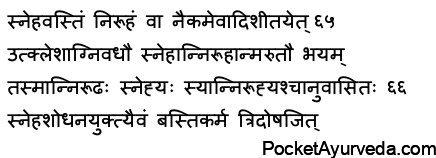

A decoction or fat-enema enema by itself should not be used for a single purpose.
The more fat-related enemas can result in nausea and loss of digestion power.
The more decoction-based enemas may result in a fear of an increase in Vata.
Therefore, those who receive a decoction enema must also be given a fat-based enema. those given fat enema also need to be given decoction enema.
The enema treatment balances the three Doshas, but only when it is both lubricating and cleansing. 65- 661/2
Matra Basti – Fat enema with low dose


Matra Basti – Low dose fat enema
Fat enema containing fat in the amount equal to the minimal amount of fat needed to make Snehakarma is referred to as Matra Basti.
In practice, a small amount of medicated oil or ghee 50 – 75ml is given in the form of Matra Basti.
Mastra basti indications
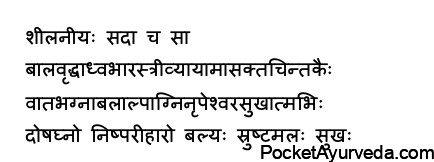

It is recommended to use it continuously to serve
Bala – children
Vriddha is the oldest,
Adhva, Bhara, Stri, and Vyayama – who are used to walking for long periods of time carrying heavy weights, exercising, and sexual activity Chinta – people who are too focused,
people suffering from fractures, vata diseases, or debility. Poor with digestive issues to kings and wealthy individuals and people who are happy.
It defeats the Doshas, doesn’t require any strict regime, provides power, and eliminates urine, faeces, and so on. effortlessly and is very comfortable. 67-69
Uttarbasti- Urethral and Vaginal Enema


Uttarbasti- urethral and vaginal enema
In the case of the vagina and urinary bladder and uterus in females, Uttarabasti is recommended for women who have been cleansed by decoctions of two or three enemas for each rectum. 70
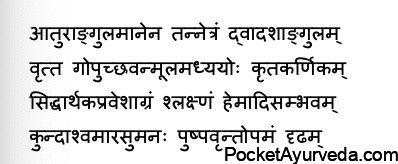

The nozzle must be 12 angula in length, measured in the terms of the patient’s own fingers an oval-shaped tubular, resembling the tail of a cow at the end must be able to open up to a mustard size. It should be made from silver, gold, and other metals It is smooth and should resemble the flower’s stalk-like Kunda, Ashvamara, and sumanas. It must be sturdy. 71-72
Uttarbasti liquid material used


The liquid used for enema should be gentle and light quickly acting, the amount of one Sukti- 24 grams or less.
Uttarabasti Procedure
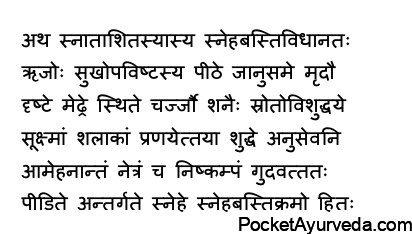

Uttarabasti Vidhi Procedure
After the patient was given food and bathed in accordance with the prescribed regimen for fat enema should be kneeling, the penis be straight by the doctor and a fine probe must be slowly introduced by the doctor and a small probe should slowly place into the urethra to clean the canal; after clearing the channel the nozzle for enema should be placed along the length of the Suture all the way to the distance of Urethal passage- until the bladder of the urinary tract is reached without shaking, and the bag is then pressed in the same manner like rectal enema. It is then pushed by pushing the fat-free oil, ghee, and so on. into the bladder of the urinary tract; this is the most effective method to enema the urethral tract. 73-75 1/2
Number of Uttarbasti can be given


In this way, at least three to four times are required and all other steps like aftercare, meals, etc. are designed in the same manner as that of the fat enema therapy. 76-76 1/2
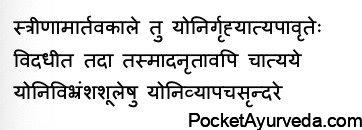

Women, Vaginal or Uterine enema or douche is best administered in the Menstrual period for the reason that it is at this point that the uterus becomes not closed; it may be administered in addition to the menstrual cycle in the event of an emergency. For conditions such as prolapsed and painful Vagina or uterus, other conditions of the uterus and vagina, and in menorrhagia. 77-78
Uttarbasti nozzle


The nozzle used for this enema must be at least ten Angulas in length and allow the passage of the grain of Mudga (green gram). it must be inspected up to a length of four Angula in cases of vaginal passage, and an Angula length in the case of the passage of urine in conditions like Dysuria or Dysuria. and for children, it should be one Angula. 79
Quantity of uttarbasti dravya


The medium amount of enema is 1 Prakunca Pala = 48 g as well for children , one Sukti- half Pala=24 grams only.
Uttarbasti position dose quantity and days
The female, lying on a cot , with her face towards the sky with her legs folded at the knees, and straight, should be given the Vaginal or Urethal enema at least three or four times during the day and at night. It is recommended to be kept over a period of three consecutive days with the intention of increasing the amount of liquid fat enema daily;
After a gap of three days, it is recommended to administer the medication again for an additional period of three (3) days. 81-82
Samanya Basti kala – Periods of administration of enemas generally


Samanya Bastikala- periods of administration of enema generally
Treatment for purgation is best resorted to at least a fortnight post an emesis treatment
and decoction enema following one week after treatment for purgation,
The treatment for fat enema must be administered as soon as possible following the decoction enema, but not until seven days following the purgation treatment. 83


As the cloth absorbs the color of the water, boiling with Kusumbha and other coloring substances, similarly, the enema absorbs the Doshas from the body that is moistened. 84
Basti Chikitsa’s importance – Basti Chikitsa Sresthata – It is important to know that basti chikitsa has a significant role in vata vyadhi


Basti Chikitsa Sresthata
All the illnesses that are located in those regions: Shakha (extremities), Koshta (alimentary tract), Marma (vital organs) All the organs that are above shoulders, there isn’t any other cause more vital than Vata.
Vata is the responsible for transporting and degrading the increasing Faeces, Kapha, Pitta and other Malas – wastes;
To counteract the significantly more Vata There is no more effective treatment than enema therapy.
Thus, the term “half of treatment” is used to describe being half in the therapy (Ardha Chikitsa) for all illnesses and some other authorities state that it’s a complete treatment.


In the same way, Sira Vyadha – venesection treatment is thought to be effective for affected blood vessels that have vitiated. 87
Siravyadha can be described as a remedy that can be done either half or fully for blood that is vitiated or increased in volume. This can be the reason for illnesses both internal and external.
The chapter is now complete. Basti Vidhi, the 19th chapter in Sutrasthana in the Astangahrdaya Samhita.
FAQ’s of Basti chikitsa
what are the types of basti chikitsa?
Niruha, Anuvasana and uttarabasti
who are the indications of niruha basti yogya?
gulma,anaha,gout,pleeha,shuddha atisara,sholla,jeernajwara,pratishyaya,shukra anila mala graha,vardhma,ashmari,rajonasha,vata related illness
what are the contraindications of niruha basti?
Atisnigdha,urakshata,krusha,ama,atisara because of ama,vomitting,navana nasya,shvasa,copd,asthma,dyspneoa,praseka,arsha,hikka,adhmana,alpavahni,shunapayu,ahara,chidra udara,ascites,kushta,madhumeha,pregenent more than 7 months.
what is basti in panchakarma?
in ayurveda basti chikitsa is described to pacify vata dosha, in which medicines are to be introduced through anal route.
who are unsuitable for anuvasana basti?
pandu,kamala,meha,peenasa,niranna,pleeha,diarrhea,hardstool,consipated,kaphodara,abhishyandi,brusha sthula,krumi koshta,gout,who consumed poison, goitre,filariasis
what are the requirements of basti netra – enema nozzle?
made up of silver,gold,bamboo,bone gopucchakara shape of tail of cow, achidra straight, smooth with gulimukha and tip resembles of pill
what is the ideal size of basti nozzle as per age?
1 – 7 years old The age is 6 Angula
7 years, it’s 7 Angula. 12 years and 8 Angula
16 years and 9 Angula
20 years from now is best to limit it to 12 angulas.what is the ideal diameter of basti nozzle as per age?
1 angula upto 1 year of age, then increased 1/2 angula till maximum 3 angula
what is the quanity of niruha basti?
upto 1 year 48gm, increase 48gms each year till 12 years so 12 years = 576gms, then increase 96gms till 18 years of age so 18 years 1152gms till 70 years of age then gradually decrease the dose after 70 years
what is the quanity of anuvasana basti?
1/4th of niruha basti that is 1152/4 = 288gm
what to do before basti chikitsa?
After snehapana, abhyanga, swedana and virechana karma daily after abhyanga and swedana niruha basti empty stomach and anuvasana basti after food is to be given.
How to give Basti?
After abhyanga and swedana person has to lie on left lateral position with bending his right knee and then catheter must be well lubricated and inserted into rectum slowly ask the patient to inhale deeply through open mouth and after inserting the catheter one must gradually with same force push the basti dravya through basti putaka.
How much time if indicated to retain anuvasana basti?
3 yama = 3*3 = 9hours
How much time if indicated to retain Niruha basti?
1 muhurta = 48 Minutes
To whom fat enema can be given daily?
significant increased vata, much physical exercise daily, good digestion capacity and extremely dry
what are the ingredients of niruha basti?
Honey,salt,kalka(paste),fats(oil) and decoction
what is the sequence of niruha basti dravyas?
salt,honey,kalka,fats and decoction
what is the position after giving basti chikitsa?
the patient should lie on his face up with an under-head pillow and be mentally focused on the enema. Once he has felt the urge, he should get rid of the faeces that are sitting on the heels of his feet.
what is the paschatkarma of niruha basti?
warm bath and food
what are the signs of proper anuvasana basti?
fat flowing out, along with faeces, after some time and followed by flatus movement down are signs of a proper fat enema treatment
how many fat enemas can be given?
1-3 kapha dominant disease, 5-7 for pitta and 9-11 for vata on alternate days with niruha basti
cautions while performing basti chikitsa
Be aware that Niruha Basti (decoction enema) is administered in empty stomach.
Anuvasana basti fat enema is administered shortly after food intake after the patient’s palms remain wet from hand washing, following the intake of food. (Ardra Pani Avastha)which basti should be given in vata dosha vitiation?
enema comprised of decoctions of drugs that reduce Vata, Trivrt, and Saindhava mixed with fats, and liquids with a sweet and sour flavor that are warm and administered.
which basti should be given in pitta dosha vitiation?
enema made up of a decoction of the drugs Nyagrodhadi Gana and Padmakadi Gana, which is cold and sweet, and then blended with milk, ghee syrup, sugarcane juice, and honey is ideal
which basti should be given for aggravated kapha dosha?
enemas made up from decoctions of the drugs Argwadhadi Gana, and Vastakadi gana, which are mixed with honey or cow’s urine, which have intense, hot, and pungent properties are the best.
which are the three types of enema based on the actions?
utkleshana, shodhana and shamana
what is matra basti?
matra basti is a fat enema but of low quantity e.g 50-70ml
what are the indications of matra basti?
bala,vriddha,adhva,bhara,stri and vyayama,chinta, fractures,vata diseases or debility, poor digestion
what is uttarabasti?
in uttarbasti medicated oil, ghee or decoction is administered through urethral or vaginal route in gynaecological conditions or in urological conditions in both male and females.
what is the dose for uttara basti?
The medium amount of enema is 1 Prakunca Pala = 48 g as well for children , one Sukti- half Pala=24 grams only.
what are the numbers of uttarabasti can be given?
at least three or four times during the day and at night. It is recommended to be kept over a period of three consecutive days with the intention of increasing the amount of liquid fat enema daily;
After a gap of three days, it is recommended to administer the medication again for an additional period of three (3) days.


